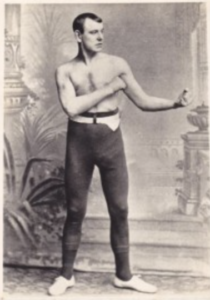
Dido Plumb – 1900
To add colour and veracity to my novels set in colonial Australia, I have spent and continue to spend a lot of time in research. One continuing difficulty I have found is the propensity for towns and places to change their names over time. For example, in 1854, in the goldfields north of Melbourne, a town called Bendigo changed its name to Sandhurst (after the military college in England). It was then changed back to Bendigo in 1891 following a plebiscite when 1,515 residents voted in favour with only 267 against.
But where did the name of Bendigo originate and why was it so popular? I dug deeper.
It seems that Bendigo creek was the original inspiration, and this was named after a local shepherd. And no, the shepherd wasn’t a Mr Bendigo. He was given this nickname because of his fighting style which was similar to a famous English boxer of the time whose real name was William Abednego Thompson. His nickname became Bendigo.
My great grandfather was a man named Dido Plumb who was the World, Imperial Empire & English Middleweight champion in 1900 (defeating Australian Jim Ryan by knock out in the 8th round at Covent Garden) and my father represented the Metropolitan Police at middleweight, so I was intrigued by Bendigo – a name that was new to me.
Bendigo was born in 1811, in Nottingham, England. Today most people would not know of him but in his day, he was as famous as any of today’s world champions. His charismatic personality, exceptional boxing skills, and his tumultuous life outside the ring made him a legend both during his time and in the years that followed.
Bendigo’s nickname, derived from the Biblical character Abednego, was given to him during his youth symbolizing his unyielding spirit and ability to endure in the face of adversity, a trait that would serve him well in his boxing career. He quickly gained a reputation as a formidable fighter in the rough and tumble world of 19th-century boxing and was known for his incredible stamina and his aggressive style. He was not the biggest of fighters, but he more than made up for it with his lightning-fast footwork and precise punches.
Bendigo was also known for his eccentric and colourful personality. He was a showman who entertained the public not just with his fighting skills but also with his witty banter and charismatic presence. His entrance to the ring was often a spectacle in itself, involving music, costumes, and dramatic flair which made him a crowd favourite and helped elevate the sport of boxing to new levels of popularity (Cassius Clay was not the first showman in the ring….).
His rivalry with another famous British boxer, Ben Caunt captured the public’s imagination. Their series of bouts, which took place between 1838 and 1845, secured them a place alongside two other renowned fighters, William Perry and Nat Langham. They were known as “The Big Four of England”. Bendigo’s clashes with Caunt were legendary, with the pair trading victories in a series of closely contested battles. The most notable of his fights took place in 1838, in front of an enormous, riotous crowd, when Bendigo defeated Caunt after 75 rounds.
Bendigo was known for his combative personality both in and out of the ring and he was no stranger to prison, serving time for various offenses, including assault and robbery. However, despite his turbulent life, his popularity as a boxer remained strong, and he continued to draw large crowds to his fights.
He also wrote several songs and poems, many of which focused on his life experiences and his love for the sport of boxing. His literary contributions added to his mystique and helped shape the public’s perception of him.
Bendigo’s retirement marked the end of an era in British boxing. He fought his last match on September 9, 1853, against the American boxer Aaron Jones, a fight that he lost. His retirement was met with a mixture of sadness and relief from the public. He had entertained and enthralled audiences for years, but his lifestyle had taken a toll on his health.
After retiring, Bendigo found religion and became a devout Christian. This transformation added another layer to his already complex personality. He became a preacher, spreading the word of God and encouraging people to turn away from the vices he himself had once been entangled in.
Bendigo passed away in 1880, at the age of 68. In the end, Bendigo was more than just a boxer. He was a symbol of resilience, tenacity, and the human spirit’s capacity for change and redemption.
Given his reputation, perhaps it’s not surprising that the citizens of Sandhurst preferred to live in Bendigo where life on the goldfields was tough and required perseverance, strength and courage to win out.